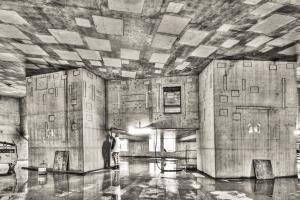Back to the underground cathedral
In the last issue of Newsline we shared a picture of the Tokamak's subterranean world, showing the cavernous space that exists between the lower basement slab (B2) and the next-level slab (B1) of the Tokamak Complex. "What is today a vast open space around the Tokamak assembly arena," the article said, "will one day be occupied by the dense piping of the cooling water system primary circuit."
Click here to watch the animation.
Miikka Kotamaki of the ITER Design Integration Division has created a GIF image that brings home the reality of those words, by showing how the space will progressively fill up with pipes, cables, feeders and busbars.
The sequence is as follows: first the piping for building services such as compressed air, demineralized water, liquid and gaseous nitrogen, helium, fire protection, and drainage is set into place (in blue); followed by cable trays (light grey), cryolines (deep blue), and cooling water lines (not visible as they are located behind and above the camera's viewpoint).
Next come additional cable trays (light grey), massive magnet feeders and feeder boxes (yellow) and busbars (gold). Other ancillary equipment such as fast discharge units is introduced and connected to the feeder boxes.
The last step in transforming the subterranean cathedral into a forest of piping and equipment is the installation of vacuum pipes and pumps and their connection to the feeder boxes (light blue).
While Miikka was busy creating his animation, a German artist—photographer Christian Luenig, whose work on ITER we presented in June 2015—was experimenting with a different approach: the drypoint drawing, which perfectly expresses the mineral atmosphere of ITER's underground cathedral.


